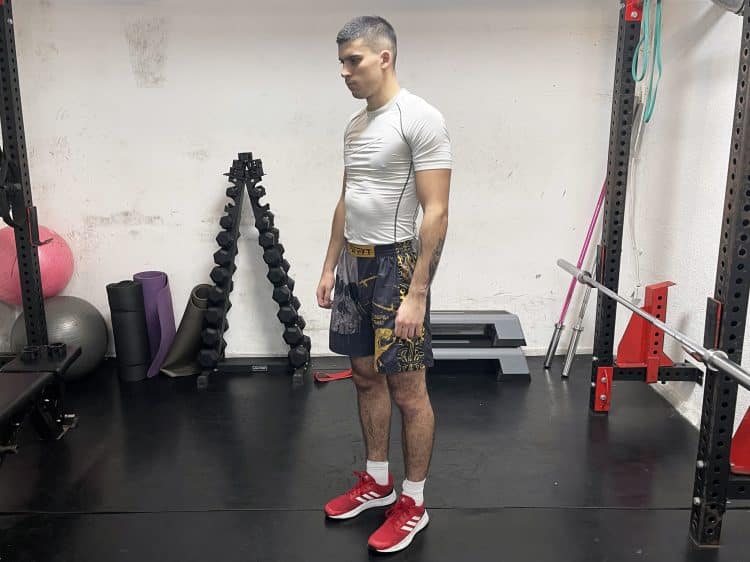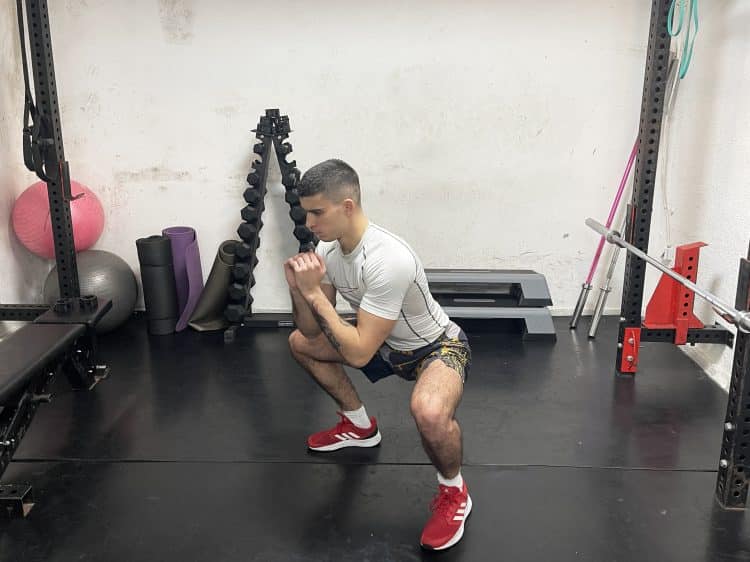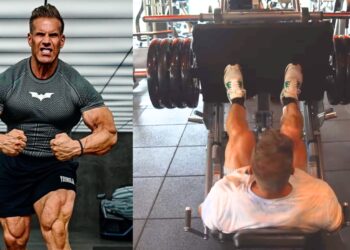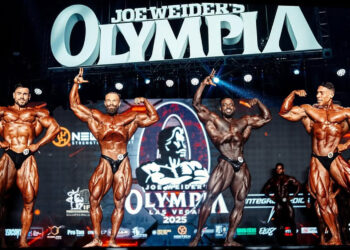I regularly implement pop squats into my warm-ups and light plyometric sessions. They are effective at improving the health and reactiveness of the joints while also preparing them better for the ensuing workout.
Pop squats are a semi-explosive movement that will fire up fast-twitch muscle fibers.
A study titled “Current Concepts of Plyometric Exercise” suggests that plyometric movement improves your neuromuscular coordination, training the nervous system and making movements more automatic during workouts. (1)
Another systematic review titled “The Efficacy and Safety of Lower-Limb Plyometric Training in Older Adults” suggests that plyo training positively affects strength, jump performance, and physical performance in older adults. (2)
Below, you will find everything you need to know about pop squats, starting from the simple guide on how to do them correctly.
How To Do Pop Squats
Below is a simple guide on how to perform pop squats:
Level Up Your Fitness: Join our 💪 strong community in Fitness Volt Newsletter. Get daily inspiration, expert-backed workouts, nutrition tips, the latest in strength sports, and the support you need to reach your goals. Subscribe for free!
Step One — Assume the Starting Position
Assume the standing starting position with your feet hip-width apart. Keep your back straight and knees slightly flexed. Place your arms at your sides.
Pro Tip: Keep your core contracted. This will ensure better stability throughout the movement.
Step Two — Jump Into a Squat
Jump your feet out so they are slightly wider than shoulder width apart and lower into a squat. Simultaneously, bring your hands in front of your chest as if you were holding a kettlebell in the goblet position.
Pro Tip: Aim to land as softly as you can. Do this by ensuring your knees are slightly flexed on impact.
Step Three — Jump Back to the Starting Position
Reverse the movement to return to the starting position. Jump from the bottom of the squat to the standing position with your feet hip-width apart. Simultaneously, move your arms to the sides of your body.
Pro Tip: Perform this phase of the exercise as fast as you can. Focus on forceful and quick jumps from the bottom squat position. This will maximize the activation of your muscle fibers while also developing more explosive strength.
Watch Vanja Vukas demonstrate the Pop Squat:
Muscles Worked in Pop Squats
The primary muscles worked during pop squats include:
- Quads
- Glutes
- Hamstrings
The secondary muscles include:
- Calves
- Adductors
- Abductors
- Deltoids
- Arm muscles
Tips For Performing Pop Squats
Some tips for performing pop squats include warming up properly, ensuring proper knee alignment, engaging your core musculature, landing softly, and progressing gradually.
Let’s cover each of these below:
Warm-up Properly
Warming up properly before every pop squat session is crucial for two reasons. First, it decreases ankle and knee injury risk. The second is to maximize your performance and the benefits you get from performing this light plyometric exercise. You should do light cardio, such as running on a treadmill, before every pop squat workout.
Also, I suggest including some light pogo jumps before the workout. This will prepare your joints for what’s coming ahead. Skipping rope is another great way to warm up.
Ensure Proper Knee Alignment
To keep your knees safe, you should prevent them from passing beyond your toes. However, if you are an athlete, powerlifter, or a more advanced fitness enthusiast without knee problems, you can skip this tip.
Level Up Your Fitness: Join our 💪 strong community in Fitness Volt Newsletter. Get daily inspiration, expert-backed workouts, nutrition tips, the latest in strength sports, and the support you need to reach your goals. Subscribe for free!
You will likely achieve more significant benefits and activation if you allow your knees to pass your toes.
Engage Your Core
Engage your core to achieve better stability throughout the exercise. Activating your rectus abdominis and obliques will ensure you remain stable in all planes of motion. By doing this, you’ll not only gain greater stability but also enhance the precision of your landings.
This is crucial if you want to get the most out of pop squats since the wrong width during landing can increase injury risk.
Land Softly
Landing softly is crucial to absorb the force effectively. Your joints are the first mechanism that absorbs the force during landing.
This is one of the reasons why so many coaches make their athletes master eccentrics before proceeding with a more complex plyo workout.
Progress Gradually
As you become more experienced with pop squats, increase the number of repetitions in each set. You can start with as little as three to four jumps and progress to 12-15. However, if you progress too quickly, you will likely injure yourself.
My dad, who was a Greco-Roman wrestler for over two decades, advised me that as a child, muscles respond quicker to specific workouts than the joint system. Essentially, he told me not to do too much too soon.
Later, I verified this through various studies, which emphasize that joints, tendons, and ligaments mature slower than other body tissues. (3). For all youngsters, please be careful with how much progressive overload you include in your workouts.
Mistakes To Avoid During Pop Squats
Here are some mistakes to avoid when performing pop squats:
Improper Foot Placement
A common mistake many individuals make is that they place their feet too close during concentrics and too far apart during eccentrics. In my experience, a stance around shoulder-width apart works perfectly. You have enough stability and ability to generate force and achieve desirable squat depth.
Rounding the Back
Rounding your back is another common mistake. Rounding either your lumbar or thoracic spine is a mistake, and you can potentially injure yourself. Avoid this by contracting your core muscles to stabilize the entire spine.
Inconsistent Squat Depth
Shallow squats will likely reduce the effectiveness of this exercise. Your thighs must be parallel to the floor at the bottom of the range of motion. This will ensure the majority of your muscle groups are activated.
Rushing the Movement
Don’t rush while performing pop squats, as this will hinder your form and technique. Focus on controlled movements, especially during the lowering part of the exercise. This will also ensure you stabilize your body properly, reducing the risk of injuries.
Forgetting to Breathe
Typically, many people are unaware of the importance of proper breathing in any exercise. Inhale during the lowering portion of the exercise and exhale sharply during concentrics. Also, you can incorporate abdominal breathing to increase your performance.
Pop Squats Alternatives
Here are some pop squats alternatives you can consider:
Jump Squats
Jump squats are an excellent exercise for improving explosive strength.
Steps:
- Assume a standing starting position with your feet hip-width apart.
- Ensure your back is straight throughout the entire exercise.
- Keep your arms bent in front of your body.
- Simultaneously, bend your ankles, knees, and hips to lower into a squat.
- Stop when your thighs become parallel to the ground and drive your arms behind your body.
- Explosively jump from the ground and extend your arms overhead.
- Proceed immediately with the following rep without stopping.
Pro Tip: Focus on your landing technique. Always land softly with your knees slightly bent to absorb the impact.
Squat Jacks
Squat jacks are an intense exercise that will develop lower body endurance. It is a great warm-up exercise as well.
Steps:
- Assume a standing starting position with your feet shoulder-width apart.
- Lower into a squat. Your thighs should be slightly above parallel.
- Keep your arms bent in front of you or wherever they are most comfortable.
- Keep your back straight throughout the exercise.
- Explosively jump your feet out to the sides.
- Jump back in a squat and repeat for the desired reps.
Pro Tip: Focus on engaging your inner thigh muscles (adductors) during the exercise. As you jump your feet back together from the squat position, actively squeeze your inner thighs.
Wrapping Up
Pop squats are an excellent exercise for developing explosive strength and improving joint health. Some tips for performing pop squats efficiently include warming up properly, keeping your knees aligned, landing softly, engaging your core, and progressing gradually.
The most common mistakes you should avoid include improper foot placement, rounding your back, inconsistent squat depth, rushing the movement, and forgetting to breathe. In the comments below, let me know your thoughts on pop squats and how you incorporate them into your workouts.
References
- Davies G, Riemann BL, Manske R. CURRENT CONCEPTS OF PLYOMETRIC EXERCISE. Int J Sports Phys Ther. 2015;10(6):760-786.
- Vetrovsky T, Steffl M, Stastny P, Tufano JJ. The Efficacy and Safety of Lower-Limb Plyometric Training in Older Adults: A Systematic Review. Sports Med. 2019;49(1):113-131. doi:10.1007/s40279-018-1018-x
- Bordoni, B. (2023, November 9). Anatomy, Tendons. StatPearls – NCBI Bookshelf.
Relevant Articles:
Interested in measuring your progress? Check out our strength standards for Squat.










